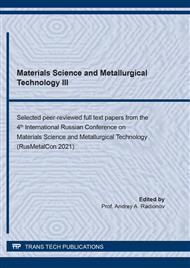[1]
J. Thonstad, P. Fellner, G.M. Haarberg, J. Híveš, H. Kvande, A. Sterten, Aluminium Electrolysis, 3rd edition, Aluminium Verlag, Dusseldorf, (2001).
Google Scholar
[2]
K. Grjotheim, B. Welch, Aluminium Smelter Technology, Aluminium Verlag, Dusseldorf, (1993).
Google Scholar
[3]
F. Yan, M. Dupuis, J. Zhou, S. Ruan, In depth analysis of energy-saving and current efficiency improvement of aluminum reduction cells, in: Light Metals. (2013) 537-543.
DOI: 10.1002/9781118663189.ch91
Google Scholar
[4]
V. Mann, V. Buzunov, N. Pitertsev, V. Chesnyak, P. Polyakov, Reduction in power consumption at UC Rusal's smelters 2012-2014, in: Light Metals. (2015) 757-762.
DOI: 10.1002/9781119093435.ch128
Google Scholar
[5]
V.U. Bazhin, A.D. Smol'nikov, P.A. Petrov, Concept of energy efficiency aluminum production Electrolysis 600+,, Intern. Research J. 5(3) (2016) 37-40.
Google Scholar
[6]
J. Haraldsson, M. Johansson, Review of measures for improved energy efficiency in production-related processes in the aluminium industry - From electrolysis to recycling, Renewable & Sustainable Energy Reviews. 93 (2018) 525-548.
DOI: 10.1016/j.rser.2018.05.043
Google Scholar
[7]
I.A. Rodionova, The shifts in the spatial structure of the world bauxite industry and Guinea's position in the industry, Revista ESPACIOS. 41(21) (2020) 11-21.
Google Scholar
[8]
O.A. Dubovikov, V.N. Brichkin, A.D. Ris, A.V. Sundurov, Thermochemical activation of hydrated aluminosilicates and its importance for alumina production, Non-Ferrous Metals. 2 (2018) 11-16.
DOI: 10.17580/nfm.2018.02.02
Google Scholar
[9]
A.A. Vlasov, V.M. Sizyakov, V.Yu. Bazhin, Use of sandy alumina for aluminum production. Proc. of Irkutsk State Techn. University. 21(6) (2017) 111-118.
DOI: 10.21285/1814-3520-2017-6-111-118
Google Scholar
[10]
I.I. Shepelev, N.V. Golovnykh, A.Yu. Sakhachev, A.M. Zhyzhaev, A.G. Kotlyagin, Improving limestone-nepheline charge sinter quality by gypsum anhydrate technogenic raw material introduction, Proc. of Irkutsk State Techn. University. 22(5) (2018) 225-239.
DOI: 10.21285/1814-3520-2018-5-225-239
Google Scholar
[11]
G.P. Tarcy, K. Torklep, Current efficiency in prebake and søderberg cells, Essential Readings in Light Metals. 2 (2013) 211-216.
DOI: 10.1002/9781118647851.ch30
Google Scholar
[12]
A.A. Tyutrin, N.V. Nemchinova, A.A. Volodkina, Effects of electrolysis parameters on the technical and economic performance indicators of OA-300M baths, Proc. of Irkutsk State Techn. University. 24(4) (2020) 906-918.
DOI: 10.21285/1814-3520-2020-4-906-918
Google Scholar
[13]
H. Alamdari, Aluminium production process: Challenges and opportunities, Metals. 7(4) (2017) 133.
Google Scholar
[14]
D. Brough, H. Jouhara, The aluminium industry: A review on state-of-the-art technologies, environmental impacts and possibilities for waste heat recovery, Intern. J. of Thermofluids. 1-2 (2020) 100007.
DOI: 10.1016/j.ijft.2019.100007
Google Scholar
[15]
A.K. Pandey, R. Prakash, Opportunities for sustainability improvement in aluminum industry, Engineering Reports. 2(5) (2020) e12160.
Google Scholar
[16]
V. Buzunov, V. Mann, E. Chichuk, V. Frizorger, A. Pinaev, E. Nikitin, The first results of the industrial application of the EcoSoderberg technology at the Krasnoyarsk aluminium smelter, Light Metals. (2013) 573-576.
DOI: 10.1002/9781118663189.ch98
Google Scholar
[17]
G. Holywell, R. Breault, An overview of useful methods to treat, recover, or recycle spent potlining, JOM. 65(11) (2013) 1441-1451.
DOI: 10.1007/s11837-013-0769-y
Google Scholar
[18]
A.E. Burdonov, E.V. Zelinskaya, L.V. Gavrilenko, A.A. Gavrilenko, Investigation of substantial composition of alumina-bearing material of aluminium electrolysers for usage in primary aluminium technology, Tsvetnye Metally. 3 (2018) 32-38.
DOI: 10.17580/tsm.2018.03.05
Google Scholar
[19]
A.N. Baranov, E.V. Timkina, A.A. Tyutrin, Research on leaching fluorine from carbon-containing materials of aluminum production, Proc. of Irkutsk State Techn. University. 21(7) (2017) 143-151.
DOI: 10.21285/1814-3520-2017-7-143-151
Google Scholar
[20]
V. Kovács, L. Kiss, Comparative Analysis of the environmental impacts of aluminum smelting technologies, Light Metals. (2015) 529-534.
DOI: 10.1002/9781119093435.ch88
Google Scholar
[21]
X.L. Wang, Alumina Production Theory & Technology, Central South University, Changsha, (2010).
Google Scholar
[22]
R.H. Andrew, K.B. Suresh, C.G. Stephen, The surface chemistry of Bayer process solids: A review, Colloids and Surfaces A: Physicochemical and Engineering Aspects. 146 (1999) 359-374.
DOI: 10.1016/s0927-7757(98)00798-5
Google Scholar
[23]
I.V. Loginova, A.A. Shoppert, Production of active aluminum hydroxide and its use for small-sized alumina production, Izvestiya. Non-Ferrous Metallurgy. 2 (2014) 34-38.
DOI: 10.17073/0021-3438-2014-2-34-38
Google Scholar


